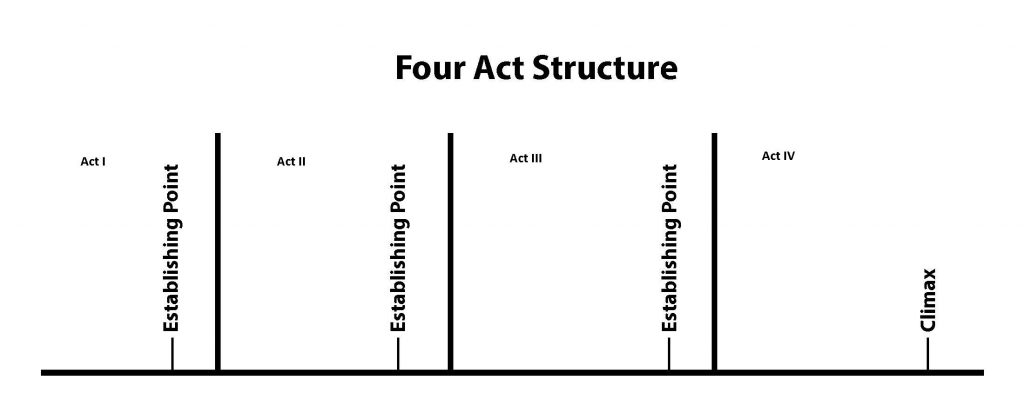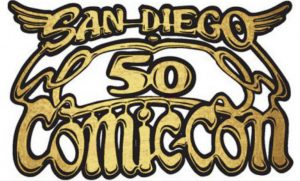 The following is an excerpt from my book How To Write A Novel: The Fundamentals of Fiction, Chapter 2:
The following is an excerpt from my book How To Write A Novel: The Fundamentals of Fiction, Chapter 2:
The four-act structure is a more recent rethinking of three-act structure. Proponents claim it is much better and more effective because it more naturally follows the flow of dramatic story. I certainly agree that for motion pictures this is probably the case, but I am not sure about novels. Regardless, the rule in writing is to use what works for you, so I present it here as an option that might be more helpful to some of you than the three-act structure.

Fundamentally, the difference between the three-act and four-act structures is that act two is now two acts, with each ending in a plot point or establishing point. Act one ends with an establishing point where the hero has a life-changing event that spurs him or her to action, essentially enabling circumstances that lead the hero to launch into the quest or journey that makes up the rest of the story and results inevitably in a confrontation with the antagonist in act one. In act one, there is no midpoint but instead an establishing point that generally consists of a hero-ally confrontation in which the hero is forced to give up his or her flaw. Act two becomes about establishing a relationship with the ally while the hero tries to hold onto his or her flaw and still complete the quest. The establishing point here reveals that the flaw is an obstacle which must be overcome to achieve success.
 After that establishing point, instead of a second half, we enter act three, which ends with an establishing point where the flaw is finally resolved, and the hero enters the ring against the opponent in preparation for act four’s final confrontation. Act three thus consists of the hero demonstrating the growth of overcoming the flaw or at least conquering and controlling it as he or she prepares with the ally to take on the antagonist. Act four is the climbing into the ring where the hero faces his or her opponent to see who will triumph.
After that establishing point, instead of a second half, we enter act three, which ends with an establishing point where the flaw is finally resolved, and the hero enters the ring against the opponent in preparation for act four’s final confrontation. Act three thus consists of the hero demonstrating the growth of overcoming the flaw or at least conquering and controlling it as he or she prepares with the ally to take on the antagonist. Act four is the climbing into the ring where the hero faces his or her opponent to see who will triumph.
In theory, using four acts makes writing the longer middle easier for writers by breaking it into two logical halves. It also puts more emphasis on a hero-ally confrontation where the flaw is confronted and overcoming begins. This can be a physical or emotional confrontation, but it is a key turning point that functions much like the midpoint in the three-act structure. This often serves to strengthen the relationship between the hero and his or her key ally.
A great example of this four-act structure can be found in the film Rocky, which is considered one of the best-structured films of all time. In act one, Rocky is on the mean streets of Philly and considers himself a loser, but is a nice, bright guy who won’t even stoop to breaking legs for work with loan sharks or other things. Then he gets the chance to fight for heavyweight champion of the world, his establishing point or life-changing event.
In act two, Rocky tries to react to this challenge but is dragged down by his lack of self-confidence. Allies come in the form of his wife, Adrian, and manager, Mickey, who push him to believe in himself, but he can’t do it until he finally confronts the memory of his father telling him he was too ugly and stupid to be anything but a boxer, so he’d better be good. Once he articulates and faces this, he regains a sense of purpose and confidence in an establishing point wherein he determines to prove his father wrong.
Act three is then the training surge when Rocky prepares for the fight with Apollo Creed and begins to think of himself as capable and strong and smart, not a loser, mentally changing and transforming into being ready for the fight.
Act four is the final fight against Creed.
As you can see here, the four-act structure depends more on character development for its turning points than the three-act structure does and really defines and clarifies the characters in a different way, which may be helpful to some of you in structuring your story and thinking it through before writing.
To download a free copy of How To Write A Novel: The Fundamentals of Fiction, click here.
